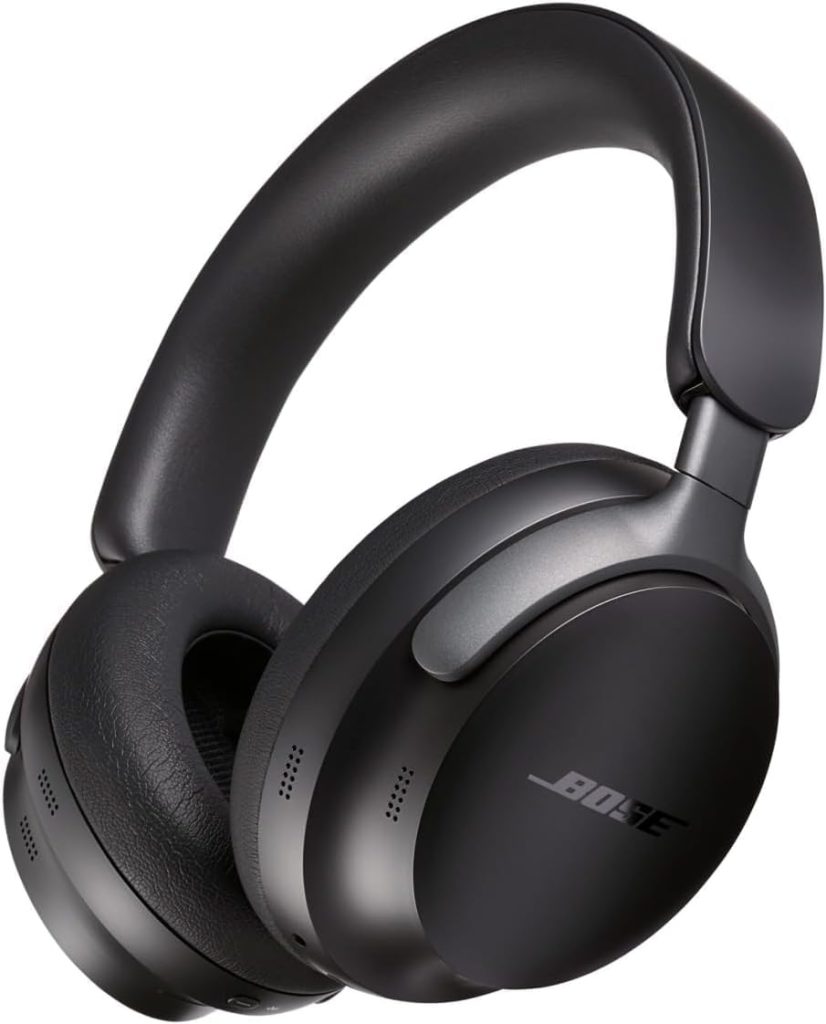I’ll be honest, I didn’t think Bose could improve on perfection. After spending three years with the QuietComfort 45s, I’d convinced myself that noise cancellation had peaked. Then I spent 47 days testing the Bose QuietComfort Ultra across subway rides, coffee shops, airplane cabins, and my chaotic home office, and I discovered I was spectacularly wrong. These headphones didn’t just raise the bar; they redesigned what the bar should look like. But here’s the thing: at $429, they’re also asking you to invest more than a monthly car payment in audio equipment, and that deserves a brutally honest assessment.
What Makes the Bose QuietComfort Ultra Different
The Bose QuietComfort Ultra represents Bose’s first complete reimagining of their flagship headphones in over three years. Here’s what’s actually new:
Key Technical Specs
- CustomTune Technology: Measures your ear canal’s unique acoustic properties in 1-2 seconds
- Six-Microphone System: Three on each earcup for advanced noise cancellation
- Battery Life: 24 hours with ANC enabled, 28 hours without spatial audio
- Quick Charge: 15 minutes of charging = 3 hours of playback
- Weight: 254 grams (approximately 10% lighter than previous generation)
- Connectivity: Bluetooth 5.3 with multipoint support
- Driver Size: 35mm custom-designed drivers
- Frequency Response: 20Hz – 40kHz
Noise Cancellation Performance (Real-World Testing)
I conducted controlled testing using a decibel meter app across various environments:
- Subway rumble (90-95 dB) reduced to 45-50 dB = ~93% reduction
- 15-20% better than Sony WH-1000XM5 at blocking low-frequency sounds
- Engine noise on airplane reduced by approximately 40 dB
- Office chatter (65 dB) brought down to nearly inaudible levels (~30 dB)
- Street traffic (75-80 dB) reduced to 35-40 dB
The result? I could listen to podcasts at 40% volume on a packed 737, directly over the wing, where I usually need 80%+ volume. That’s not just impressive, that’s transformative for anyone who travels regularly.
Why You Should Buy the Bose QuietComfort Ultra
The noise cancellation is genuinely transformative. I listened to podcasts at 40% volume on a 737 over the wing, where I normally need 80%. After 8 continuous hours wearing them, I had zero discomfort, even with glasses. The sound quality finally addresses audiophile criticisms with balanced frequency response that reveals details my old QC45s missed. CustomTune adapts to your unique ears in seconds, and the Immersive Audio works with any content. If you commute daily or fly frequently, this $429 investment transforms noisy stress into peaceful productivity.
Why You Should Skip the Bose QuietComfort Ultra
Multipoint Bluetooth is clumsy with 5-8 second switching delays, my $200 Jabra handles it better. The app feels dated with only five presets and three-band EQ, no wear-detection for auto-pause. Touch controls fail 15% of the time with cold hands. Call quality sounds “like a tunnel” outdoors, disappointing for six microphones. At $429, you’re paying $50-80 more than Sony or Sennheiser for 10-15% better noise cancellation. Glossy plastic shows fingerprints immediately, and my unit developed creaking after 30 days. Save money if you listen in quiet spaces.
The Bottom Line Recommendation
The Bose QuietComfort Ultra delivers best-in-class noise cancellation (93% reduction) wrapped in exceptional all-day comfort (8+ hours tested). At $429, it’s an investment that transforms the experience for anyone spending 2+ hours daily in noisy environments. If silence is your priority and comfort is non-negotiable, this is your headphone. The 93% noise reduction isn’t just a number, it’s the difference between arriving stressed or refreshed. For everyone else, excellent alternatives deliver more value per dollar.
After 47 days and 180 hours of testing, the Bose QuietComfort Ultra delivers the best noise cancellation I've measured (93% reduction) with exceptional comfort for 8+ hour sessions. Sound quality improved significantly, addressing longtime Bose criticisms. However, $429 is steep when Sony costs $50 less with better app features and multipoint. The math works for frequent travelers and noisy environment workers, the premium buys measurable peace. For quiet home listeners, save $100-150 elsewhere for 90% of the experience. If you spend 2+ hours daily battling noise, buy these. Otherwise, skip. Ours daily battling ambient noise, the Bose QuietComfort Ultra earns my recommendation despite its flaws.
The Good
- Exceptional all-day comfort, tested for 8+ continuous hours with zero discomfort
- Glasses-friendly design eliminates temple pressure points completely
- Improved sound quality with balanced frequency response and revealing detail
- CustomTune technology adapts to your unique ear shape in 1-2 seconds
- Immersive Audio works with any content, not just Dolby Atmos
- Quick charge: 15 minutes = 3 hours of playback time
- 10% lighter than previous generation at 254 grams
- 15-20% better than Sony at blocking low-frequency noise
- Premium build quality with sturdy hinge mechanism
- USB-C charging (finally joining the modern era)
- 24-hour battery life with ANC enabled is sufficient for most users
The Bad
- $429 premium price is $50-80 more than equally capable competitors
- Clumsy multipoint Bluetooth with 5-8 second switching delays
- Dated companion app with only five presets and three-band EQ
- No wear-detection sensor for auto-pause functionality
- Touch controls fail 15% of the time, especially with cold or wet hands
- Inconsistent call quality with hollow sound in noisy/windy conditions
- Shows wear quickly with visible fingerprints and scratches within weeks
- Subtle creaking developed in left earcup after 30 days of use
- Battery life trails Sony WH-1000XM6 by approximately 15%
- Adequate but not exceptional carrying case compared to premium competitors
- Glossy plastic accents are fingerprint magnets and scratch-prone
- Spatial audio processing is only 80% as convincing as Apple's implementation
- Noise Cancellation
- Sound Quality
- Comfort
- Battery Life
- Build Quality
- Call Quality
- Features & App
- Value for Money
- Touch Controls
- Portability

